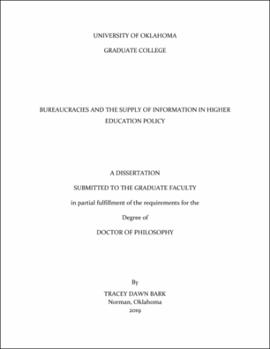| dc.description.abstract | Most discussions of the policy process begin with and focus on the legislative branch, as this is the institution most directly responsible for crafting policies. Many also bring the chief executive or interest group lobbyists into the equation through the study of executive orders and campaign contributions. In contrast, very few of these types of discussions mention the bureaucracy as an actor in this process. This project strives to rectify this oversight by investigating the role of bureaucratic agencies in directing public policy, most notably in the early stages of problem definition and agenda setting. In particular, this project views bureaucratic agencies as key providers of information on which legislation is based.
To support this argument, I draw on a number of academic literatures, including theories of attention dynamics, institutional friction, and higher education governance. At the nexus of these literatures lies the basis for the overarching theoretical argument made in this project: the influence of bureaucratic organizations on the policy process can be substantial, but is conditioned by the structural characteristics of the agency in question. This assertion is supported empirically by analyses of an original dataset drawn from the annual reports of higher education governance bodies and state legislation related to higher education in two archetypal states. The methodologies used include assessments of various distributional characteristics, correlations, and regression models.
The findings from these models demonstrate institutional structure can have a substantial impact on the agendas of bureaucratic organizations. A highly centralized organization is limited in its ability to attend to a broad array of substantive topics at once, resulting in a narrower and more volatile agenda. This in turn leads to greater difficulty in influencing legislative debates. A less centralized organization, however, is better able to maintain attention on a large number of issues simultaneously. This allows an agency to have a broader and more stable agenda, facilitating greater influence on subsequent bill introductions in the state legislature.
Overall, the results demonstrate support for the central hypothesis in that the decentralized organization (the Illinois Board of Higher Education) had tangible impacts on its state’s legislature while the centralized organization (the Kansas Board of Regents) did not. These findings deepen our understanding of the impacts of bureaucratic structure on agency outputs and suggest that bureaucrats can have a broader role in the policy process than often recognized through the information they provide to legislators. Additionally, this study connects theories of agenda setting and problem definition to the state level and produces a dataset for future exploration of similar questions. | en_US |
